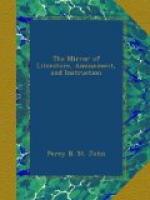Miss Benger, in her agreeable Memoirs of Anne Boleyn, does not mention the Queen’s abode in Southwark; but the date of the architecture of the annexed house, and its closer identification with Queen Elizabeth, render the first mentioned circumstance by no means improbable. Previous to the marriage of Anne Boleyn, we learn that Henry passed not a few of his leisure hours “in the delightful society of Anne Boleyn.” “Every day they met and spent many hours in riding or walking together.” Her family at this time resided at Durham House, on the site of the Adelphi, and Anne frequently made excursions with Henry in the vicinity of London.
Of the antiquity of this district we could quote more proofs. The galleried inn-yards, and among them that at which the Pilgrims sojourned on their road to Canterbury, are among them. In our last volume too, at page 160, we engraved an ancient Vault in Tooley-street, the remains of the “great house, builded of stone, with arched gates, which pertained to the Prior of Lewis, in Sussex, and was his lodging when he came to London.” Not far from this was “another great House of Stone and Timber,” which, in the thirteenth century, was held of John, “Earl Warren, by the Abbot of St. Augustins, at Canterbury.” Stowe says—“It was an ancient piece of worke, and seemeth to be one of the first builded houses on that side of the river, over against the city: it was called the Abbot’s Inne of St. Augustine in Southwark.”
There was also another “Inne” near this spot, which belonged to the Abbey of Battle, in Sussex, and formed the town residence of its Abbots. This stood on the banks of the Thames, between the Bridge House and Battle Bridge, which was so called, “for that it standeth on the ground, and over a water-course (flowing out of Thames) pertayning to that Abbey, and was therefore both builded and repayred by the Abbots of that house, as being hard adjoyning to the Abbot’s lodging.” Its situation is known by the landing-place called Battle Stairs. On the opposite side of Tooley-street is a low neighbourhood of meanly-built streets and passages, still denominated the Maze, from the intricacies of a labyrinth in the gardens of the Abbot of Battle’s Inn, and which fronted its entrance-gate.
With these few quotations of the ancient importance of Southwark, we can but repeat our regret that no regular history of this district has yet been published. There are three or four gentlemen resident there, whose antiquarian attainments highly qualify them for the task. The public would surely find them patronage.
The Engraving is from an original sketch by an ingenious Correspondent, M.P. of Upton, near Windsor, whom we thank for this specimen of good taste. We are always happy to receive antiquarian illustrations of our Metropolis, and in this instance the zeal of the artist, who resides twenty miles distant, deserves special mention.
[1] See Mirror, vol.
xiii. p. 227. Gower is buried here,
Fletcher
and Messenger too; and not long since the bones of
Bishop
Andrews chapels for the New London Bridge approach.—See
also
Mirror, vol. xvi. p. 297.




